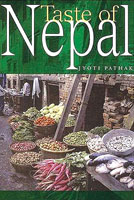


|
|
When Jyoti Pathak (pictured, right) went to live in the United States 40 years ago, she did her household chores, spending a lot of time in the kitchen trying to make Nepali meals for her doctor husband and three children.
There were not too many Indian spice shops in the remote corner of New York state where they lived, and Jyoti had to rely on friends and family bringing masala, gundruk, maseura and tama from Nepal.
There were some Indian cook books in the bookshops, but nothing about Nepali cuisine. That is when the idea to write a Nepali cookbook first came to her.
Today, nearly four decades later, Jyoti has been awarded the Best Foreign Cuisine book in the Gourmand World Cookbook Award in the US for her book, A Taste of Nepal. Jyoti was in London last week to receive another nomination for her book to be declared the best foreign cuisine book internationally.
There have been quite a few Nepali cookbooks that have come out in the past 15 years. And, marching with these more inclusive times, there are books now on Newari, Sherpa and even Thakali cuisine. Jyoti's book weaves in Nepal's history and culture and how the food here has been influenced by Tibetan and Indian culinary traditions.
|
|
Observing the mountains of rice that people eat on the food stalls along Nepal's highways, however, one could argue that it is the sheer volume of food ingested that makes Nepali diet unhealthy. Nepalis may have a low-fat diet, but the middle class ODs on carbs and does very little exercise to burn it off.
Jyoti's recipes include the simple mutton curry, and she uses the elaborate and exotic sounding Dahi Haleko Boka-Khasiko Masu which is guaranteed to make the diaspora Nepali's mouth water just hearing about it. Then there are the momos and raw marinated water buffalo and even the Basi Bhat Bhutuwa, the ingenious Nepali way to re-use leftover rice for an appetising snack.
A Taste of Nepal doesn't leave out the ingredients and recipes that make Nepali food different from Indian or Tibetan: Alu Tama, Gundruk Bhatmas ko Jhol, Maseura Alu, Jimbu, Lapsi ko Achar, Kalo Dal. Nepalis abroad may find it difficult to find these ingredients, but with 15 percent of Nepalis now living outside Nepal it is only a question of time before stores spring up stocking up on jimbu and
lapsi too.
Jyoti held long-range consultations with her family back home in Nepal and researched the 350 recipes thoroughly. "I used to cook with a pinch of this and a dash of that, but in preparing the book I actually had to go out and measure everything," she says.
Because it is primarily written for the western audience, the book has made it easy by including the masalas usually found in the ethnic food section of any US or European supermarket.
www.tasteofnepalcookbook.com




